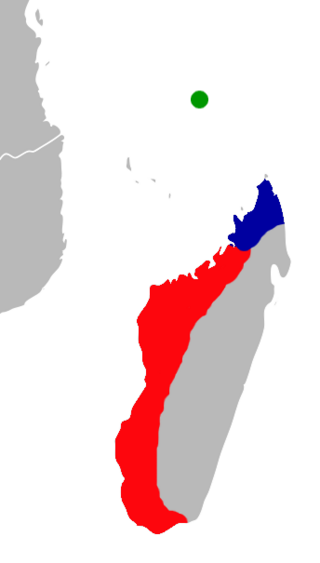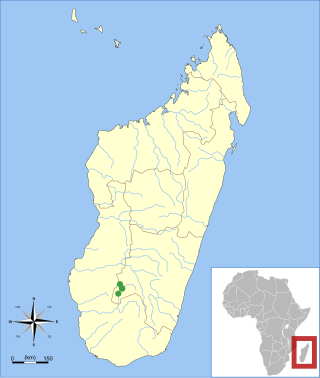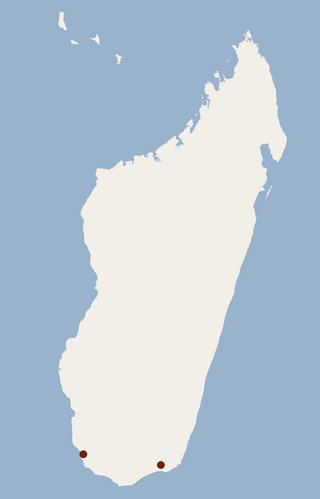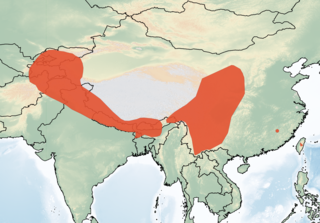
Peters's wrinkle-lipped bat, also called Peters's goblin bat, is a species of bat in the family Molossidae, the free-tailed bats. It is endemic to Madagascar, where it is widespread and in some areas abundant. It commonly roosts in human-made structures, sometimes in colonies with other free-tailed bat species. It forages in the open, often in agricultural areas. The bat is sexually dimorphic, with males larger than females.

The Malagasy serotine, is a species of vesper bat. It is found only in Madagascar. It was formerly classified in Neoromicia before phylogenetic analysis found it to belong to Laephotis.

Glen's long-fingered bat is a species of vesper bat in the family Miniopteridae found only in Madagascar.

The Manavi long-fingered bat is a bat in the genus Miniopterus that occurs in east-central Madagascar. First described in 1906, this species was later included in the mainland African M. minor. A 1995 revision united populations of small Miniopterus from Madagascar and the Comoros as M. manavi, but molecular and morphological studies in 2008 and 2009 showed that this concept of M. manavi in fact included five different species. M. manavi itself was restricted to a few locations in the eastern Central Highlands and populations in the Comoros and northern and western Madagascar were allocated to different species.

The Midas free-tailed bat is a species of bat scientifically classified in the order Chiroptera and the family Molossidae. It is distributed from western Africa to Saudi Arabia and further south. Its natural habitats are dry savanna, moist savanna, woodlands and hot deserts. The more southern are also known to live around large rivers or the swamps.

The Malagasy mouse-eared bat is a species of bat in the family Vespertilionidae that is endemic to Madagascar.

Grandidier's trident bat is a species of bat in the family Hipposideridae endemic to Madagascar. It was formerly assigned to the genus Triaenops, but is now placed in the separate genus Paratriaenops.

Paratriaenops furculus, also known as Trouessart's trident bat, is a species of bat in the family Hipposideridae. It is endemic to Madagascar. It was formerly assigned to the genus Triaenops, but is now placed in the separate genus Paratriaenops. A related species, Paratriaenops pauliani, occurs in the Seychelles.

Miniopterus, known as the bent-winged or long winged bats, is the sole genus of the family Miniopteridae. They are small flying insectivorous mammals, micro-bats of the order Chiroptera, with wings over twice the length of the body. The genus had been placed in its own subfamily among the vespertilionid bats, as Miniopterinae, but is now classified as its own family.

Triaenops menamena is a bat in the genus Triaenops found on Madagascar, mainly in the drier regions. It was known as Triaenops rufus until 2009, when it was discovered that that name had been incorrectly applied to the species. Triaenops rufus is a synonym of Triaenops persicus, a Middle Eastern species closely related to T. menamena— the Malagasy species had previously been placed as a subspecies of T. persicus by some authors. Triaenops menamena is mostly found in forests, but also occurs in other habitats. It often roosts in large colonies and eats insects such as butterflies and moths. Because of its wide range, common occurrence, and tolerance of habitat degradation, it is not considered to be threatened.

The Isalo serotine is a vesper bat of Madagascar in the genus Laephotis. It is known only from the vicinity of the Isalo National Park in the southwestern part of the island, where it has been caught in riverine habitats. After the first specimen was caught in 1967, it was described as a subspecies of Eptesicus somalicus in 1995. After four more specimens were collected in 2002 and 2003, it was recognized as a separate species. Because of its small distribution and the threat of habitat destruction, it is considered "vulnerable" in the IUCN Red List.

The Central Highlands, Central High Plateau, or Hauts-Plateaux are a mountainous biogeographical region in central Madagascar. They include the contiguous part of the island's interior above 800 m (2,600 ft) elevation. The Central Highlands are separated from the Northern Highlands of the northern tip of Madagascar by a low-lying valley, the Mandritsara Window, which has apparently acted as a barrier to dispersal for species in the highlands, leading to species pairs such as Voalavo gymnocaudus and Voalavo antsahabensis in the Northern and Central Highlands. Species restricted to the Central Highlands include the bats Miniopterus manavi and Miniopterus sororculus; the rodents Brachyuromys betsileoensis and Voalavo antsahabensis; the tenrecs Hemicentetes nigriceps and Oryzorictes tetradactylus; and the lemur Cheirogaleus sibreei. Because of the continuous habitat of the Central Highlands, there is little local endemism, unlike the Northern Highlands.

Griffith's long-fingered bat is a bat in the genus Miniopterus which occurs in southern Madagascar. M. griffithsi was previously a part of the largest family of bats, the Vespertilionidae, which consist of five subfamilies. The bat family Miniopteridae is widely distributed, ranging from the majority of sub-Saharan Africa to north Africa and Eurasia, as well as southern and southeastern Asia and Australia. Typical features of these bats include elongated third fingers, long narrow wings giving them a pointed shape when in flight, and a bent shape when folded, adding to the common name of bent-wing bats. M. griffithsi is similar to its sister species Miniopterus gleni, which lives north of the Onilahy River, while M. giffithsi lives south of it. Researchers first discovered that M. griffithsi was separate from M. gleni based on phylogeographic studies of the latter.

The Madagascar free-tailed bat or Malagasy giant mastiff bat is a species of free-tailed bat formerly included as a subspecies of the large-eared free-tailed bat, but that was later considered to be a distinct, Malagasy species. The Madagascar free-tailed bat is endemic to northern, western, and southern Madagascar.

Commerson's roundleaf bat, also known as Commerson's leaf-nosed bat, is a species of bat endemic to Madagascar. It is named after French naturalist Philibert Commerson (1727-1773). Bat populations of Africa or São Tomé and Príncipe formerly considered part of this species are now classified separately as M. gigas, M. thomensis or M. vattatus, while one from Madagascar was split off to become M. cryptovalorona. It was formerly placed in the genus Hipposideros, but moved to the resurrected Macronycteris in 2017 on the basis of molecular evidence.

Chaerephon jobimena, commonly known as the black and red free-tailed bat, is a species of bat in the family Molossidae. It is endemic to western Madagascar. With a forearm length of 45 to 48 mm, C. jobimena is somewhat larger than other Malagasy bats assigned to Chaerephon, but similar in size to Tadarida aegyptiaca.

The eastern barbastelle or Asian barbastelle is a species of vesper bat found throughout much of Asia, from Afghanistan to Taiwan.

Miniopterus sororculus is a species of bat endemic to the highland forests of Madagascar.

















